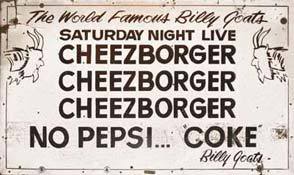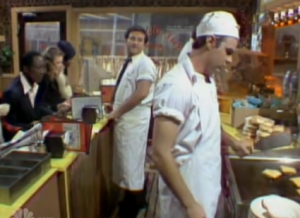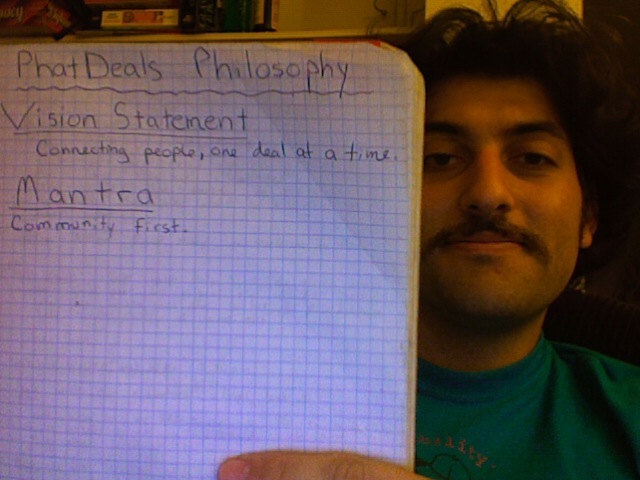April 20, 2011
So I’ve been giving PhatDeals a lot of thought lately and have tried to come up with an explanation for why we failed and what to do better next time. In this post I’ll discuss reasons why I think we didn’t succeed and ways to do it right in the future should we decide to go back to the drawing board and give PhatDeals another shot.
Why we didn’t succeed:

1. We got an office. While it was nice to have an office, we didn’t have an income to support it and it drained what little resources we did have. I had a perfectly good living room in Goleta that we could have used as our home base.
2. We got interns too late. It took us forever to get our interns in place. It’s important to deploy as many people as possible to get deals when setting this company up so our hesitation to get interns until May/June 2010 was a killer.
3. We forgot what we were aiming at in the first place. Our original pitch was that we were the Craigslist of deals/coupons. Instead of taking Craigslist’s business model of only charging a few people for select services, we tried to get a monthly subscription from every business we approached, before even proving that we could provide them business. When we did get people to sign up, it was on a trial basis so we’d only get deals up for a month or two at a time, not enough to get traction and feet stomping through their doors.
4. No funding. This ties into number 1. We never got outside funding for our project. With no money we couldn’t think outside of the box on how to expand our services. We should have been thinking national but were only focused on Santa Barbara, and Isla Vista most of that time.
5. We didn’t have a .com. I think because we had two things changed about a normal .com name (the Ph instead of f in PhatDeals and the .net instead of .com) it held us back with people remembering how to get to the site.
What I’d do differently if I had the opportunity to go forward with it:

1. Hire a new programmer to go along side with Jon. Jon’s great but he needs a companion that’s fresh and on the ball constantly challenging him to be better and improve the site.
2. Don’t charge anyone for our services. The business model is to grow large to the point where lots of people are coming to the site for their local business coupon needs, then charge for premium listings. We’d do this by having deals of the month in each category in each city at first, charging something like $10-$20 for a deal of the month; then, when we got too busy change it to deal of the week, charging something like $10 per week to have the deal in the top spot; then, when that got too busy finally move to having a deal of the day, charging $5-$10 per day to have the deal in the top position.
3. Get funding. Before getting started with the business of getting businesses to sign up, we’d need to get funding. Funding would pay for computers for our interns to take around to businesses to sign them up for the deals, and pay for the interns themselves. In California there are strict limitations on the difference between an employee and an intern, and having them go around to different businesses conducting “sales” falls pretty squarely in the role of employee. So we’d need to pay the interns at least minimum wage if not higher. I’d approach John Greathouse, my Entrepreneurship teacher from the UCSB Technology Management Program to ask his advice on whether we have a chance at funding or not without sales figures to show. Â Maybe we’d get an audience with the Tech Coast Angels. The question is- would you invest in the next Craigslist?
4. I propose that with funding (Something on the order of $1M to cover us for a window of about 2-3 years) we start in one large target market. I think San Francisco would make an excellent target, as it is a shining example to the rest of the world of what the next technologies are. There’s lots and lots of small businesses in S.F. and many of them are tech savvy.
5. Before we got funding, we might have to code up the remainder of the site. There’s a lot left to do, though we’re most of the way already there. We need to have multiple cities enabled, with their locations already defined in google maps and give the businesses the opportunity to input their addresses into this system. We need to build the opt in to premium listings in order to show the investors what it will look like (maybe we don’t need to do this yet. I’m not sure if saying we’ll do it later is enough.) We might need to get a credit processing section of the site as well. (Again, not sure if this is necessary as it’s not in the plan to start charging until much later.) Make it so that businesses have to manually remove a deal in order for it to come off the site. This way we don’t have to worry about expiration dates. Maybe. Also, give businesses the ability to send their deal to the top of the list by deactivating and reactivating the deal a maximum of once per day. This way they can control their listing if they so choose and also they can’t abuse it by constantly sending it to the top. Yeah. I guess there’s less to do that I thought. That’s kinda exciting.
6. Slowly and quietly build a repertoire of local businesses with postings with either no expiration dates on them or expiration dates of 6 months – 1 year or so on them. Possibly require that the deals be for a minimum of 25% off.
7. Either secure the PhatDeals.com domain or get a new domain with a .com.
So that’s it. That’s what I would do better this next go around. It’s relying upon getting funding. I wouldn’t do it without funding, as I simply cannot afford to. Besides, this is the next Craigslist. It’s a long and hardfought battle to finally making a profit and requires years of hard work to get there. The only way it’s going to fly is with a strong funding base to get us there.
Thanks for reading,
Aaron




 If you enter your zip code or city as being within Isla Vista or Goleta, you get to see the deals we have in Isla Vista and Goleta.
If you enter your zip code or city as being within Isla Vista or Goleta, you get to see the deals we have in Isla Vista and Goleta.


 It says: PhatDeals Philosophy. Vision Statement: Connecting people, one deal at a time. Mantra: Community first. These are the guiding principles behind PhatDeals. Our
It says: PhatDeals Philosophy. Vision Statement: Connecting people, one deal at a time. Mantra: Community first. These are the guiding principles behind PhatDeals. Our